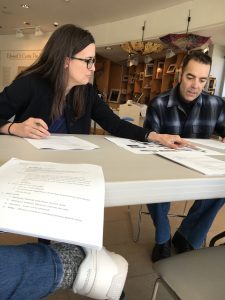Interns Don’t Fetch Coffee
I have been lucky enough to have had assisted with lots of different tasks and projects here at DuMA as a curatorial intern, and no, I don’t go on coffee runs. Though, let’s be real, I would probably oblige, because the typical working and/or studying Millennial can’t always afford to say no. But I digress. That’s something I find exciting about the smaller institutions, while at times it can be demanding and stressful, often you’re helping with the many different happenings at the museum. From installations, to recording gallery audio guides, to exhibition planning… to even this blog! I’ve had the opportunity to learn so much, and that’s what has made my internship so fruitful.
Therefore, internships are entirely essential for Museum Studies students, and most students, for that matter. This real-world experience cannot be replicated in a classroom. In the classroom, I’ve learned about the theory of the museum experience and visitor motivations, but how do I consider these ideas when I’m writing about Charles Thwaites’ artistic influences, and I need to concisely include interesting points, that are not only related to the content in the exhibition, but are in a language that many walks of life will understand and want to listen to when they phone in to the audio guides? Application. Internships not only exercise the muscles students have tirelessly been developing in the classroom, they also gather the experiences they will need when venturing out into the world looking for a job.

Now that my time at DuMA is approaching the end, one of the final bigger projects I’ve been assisting with is the early stages of exhibition planning for the upcoming Craft Invitational. It has been an interesting insight into the conceptualization of an exhibition, selecting artists, editing object checklists, and brainstorming programming ideas. As a wannabe curator, I anticipate this kind of organizing in future projects, and while school has been preparing me for the field, it couldn’t have prepared me in a way quite like this project has. Artist and object checklists, I’ve come to learn, are essential, and one of my tasks during this project has been to constantly edit the exhibition checklists with new or changing information. Not only do they keep things organized for the curator’s benefit as well as the artist’s benefit, but they also allow for the curator to become familiarized with the artist’s work and the objects to be exhibited prior to them physically being present at the museum. Also, one thing I’ve always believed, and have witnessed during this project, it to utilize the expertise of others. The co-curators, artists themselves, relay their knowledge of craft and how craft is presented in gallery spaces. These are just a couple of things I’ve encountered during this project, and it has been so incredibly exciting to watch the exhibition come to fruition.
Be sure to keep an eye out for Handmade Craft Invitational that’ll be exhibited from June 2 to September 9, 2018!
By Katherine Hellberg, Intern at Dubuque Museum of Art